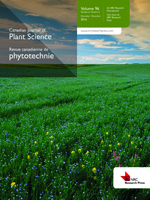Badu-Apraku, B., Akinwale, R. O., Obeng-antwi, K., Haruna, A., Kanton, R., Usman, I., Ado, S. G., Coulibaly, N., Yallou, G. C. and Oyekunle, M. 2013. Assessing the representativeness and repeatability of testing sites for drought-tolerant maize in West Africa. Can. J. Plant Sci. 93: 699-714. The selection of suitable breeding and testing sites is crucial to the success of a maize (Zea mays L.) improvement programme. Twelve early-maturing maize cultivars were evaluated for 3 yr at 16 locations in West Africa to determine the representativeness, discriminating ability, and repeatability of the testing sites and to identify core testing sites. Genotype main effect plus genotype by environment interaction (GGE) biplot analysis revealed that Zaria (Nigeria), Nyankpala (Ghana), and Ejura (Ghana) displayed the highest discriminating ability. Two mega-environments were identified. Bagou, Nyankpala, Bagauda, Ikenne, and Mokwa constituted the first mega-environment (ME1); Ejura, Ina and Sotuba represented the second (ME2). The ME1 would be more useful for evaluating early maize genotypes for tolerance to drought than ME2 because locations in ME1 were more strongly correlated to Ikenne (managed drought stress site). Among the test locations, Bagou and Mokwa were found to be closely related to Ikenne in their ranking of the cultivars for drought tolerance; Zaria was the exact opposite, indicating that this was the least suitable location for evaluating genotypes for drought tolerance. Nyankpala and Ikenne were identified as the core testing sites for ME1 and Ejura for ME2. TZE Comp 3 C2F2 was identified as the highest yielding cultivar for ME1 and Syn DTE STR-Y for ME2, indicating that they could be used as check cultivars. Ikenne, Nyankpala, and Ejura had moderately high repeatability. They were closer to the average environment axis of each mega-environment and will be useful for culling unstable genotypes during multi-locational testing. Other sites were less representative and not repeatable and will not be useful for evaluating early maize cultivars for drought tolerance.
How to translate text using browser tools
1 July 2013
Assessing the representativeness and repeatability of testing sites for drought-tolerant maize in West Africa
B. Badu-Apraku,
R. O. Akinwale,
K. Obeng-antwi,
A. Haruna,
R. Kanton,
I. Usman,
S. G. Ado,
N. Coulibaly,
G. C. Yallou,
M. Oyekunle
ACCESS THE FULL ARTICLE
It is not available for individual sale.
This article is only available to subscribers.
It is not available for individual sale.
It is not available for individual sale.

Canadian Journal of Plant Science
Vol. 93 • No. 4
July 2013
Vol. 93 • No. 4
July 2013
Core testing sites
diagramme de double projection GGE
drought stress
GGE Biplot
maïs
maize
Principaux sites d'essai




